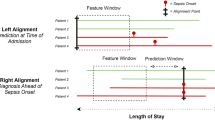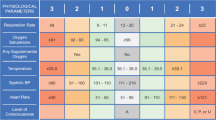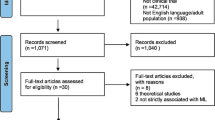Abstract
This paper describes a computational approach to assessing 30-day post-hospital discharge mortality risk. The idea of the constructed model is partially based on the popular LACE (Length of stay, Acuity, Comorbidities and Emergency visits) model, and combines elements of APACHE II (Acute Physiology and Chronic Health Evaluation) and IPEC (Inpatient Evaluation Center of Veterans Health Administration) mortality models. The resulting C-LACE2 model includes length of stay, acuity, comorbidities, selected lab values and medications. The process of construction of the model and its validation are presented in details. The constructed final model consists of 101 attributes, and its minimum version of 20 attributes. C-LACE2 has been constructed by applying machine learning methods to MIMIC III inpatient EHR data. The model achieved accuracy (AUC) of 0.779. Detailed analysis of the C-LACE2 model has been performed to check its sensitivity to inputs.











Similar content being viewed by others
References
DesHarnais SI, Chesney JD, Wroblewski RT, Fleming ST, McMahon LF Jr. The risk-adjusted mortality index: a new measure of hospital performance. Med Care. 1988;26:1129–48.
Rocker G, Cook D, Sjokvist P, Weaver B, Finfer S, McDonald E, Marshall J, Kirby A, Levy M, Dodek P, Heyland D, Guyatt G. Clinician predictions of intensive care unit mortality. Critical Care Med. 2004;32(5):1149–54.
Inouye SK, Peduzzi PN, Robison JT, Hughes JS, Horwitz RI, Concato J. Importance of functional measures in predicting mortality among older hospitalized patients. JAMA. 1998;279(15):1187–93.
Iezzoni LI. Risk adjustment for measuring health outcomes Ann Arbor. Mich: Health Administration Press; 1994.
Le Gall JR, Loirat P, Alperovitch A, Glaser P, Granthil C, Mathieu D, et al. A simplified acute physiology score for ICU patients. Crit Care Med. 1984;12(11):975–7.
Moreno RP, Metnitz PG, Almeida E, Jordan B, Bauer P, Campos RA, et al. SAPS 3 investigators. SAPS 3—from evaluation of the patient to evaluation of the intensive care unit. Part 2: development of a prognostic model for hospital mortality at ICU admission. Intensive Care Med. 2005;31(10):1345–55.
Reiter A, Mauritz W, Jordan B, Lang T, Pölzl A, Pelinka L, et al. Improving risk adjustment in critically ill trauma patients: the TRISS-SAPS score. J Trauma Acute Care Surg. 2004;57(2):375–80.
Castella X, Artigas A, Bion J, Kari A. A comparison of severity of illness scoring systems for intensive care unit patients: results of a multicenter, multinational study. Crit Care Med. 1995;23(8):1327–35.
Kuzniewicz MW, Vasilevskis EE, Lane R, Dean ML, Trivedi NG, Rennie DJ, et al. Variation in ICU risk-adjusted mortality: impact of methods of assessment and potential confounders. Chest J. 2008;133(6):1319–27.
Knaus WA, Draper EA, Wagner DP, Zimmerman JE. APACHE II: a severity of disease classification system. Crit Care Med. 1985;13(10):818–29.
Wong DT, Knaus WA. Predicting outcome in critical care: the current status of the APACHE prognostic scoring system. Canadian Journal of Anesthesia/Journal canadien d'anesthésie. 1991;38(3):374–83.
Rosenberg AL, Watts C. Patients readmitted to ICUs*: a systematic review of risk factors and outcomes. Chest J. 2000;118(2):492–502.
van Walraven C, Dhalla IA, Bell C, Etchells E, Stiell IG, Zarnke K, et al. Derivation and validation of an index to predict early death or unplanned readmission after discharge from hospital to the community. Can Med Assoc J. 2010;182(6):551–7.
van Walraven C, Wong J, Forster AJ. LACE+ index: extension of a validated index to predict early death or urgent readmission after hospital discharge using administrative data. Open Medicine Journal. 2012;6(3):e80.
Wojtusiak J, Elashkar E, Nia RM. C-Lace: Computational Model to Predict 30-Day Post-Hospitalization Mortality. In Proceedings of the 10th International Joint Conference on Biomedical Engineering Systems and Technologies (BIOSTEC 2017), pp 169–177.
Porock D, Parker Oliver D, Zweig S, Rantz M, Mehr D, Madsen R, et al. Predicting death in the nursing home: development and validation of the 6-month minimum data set mortality risk index. J Gerontol Ser A Biol Med Sci. 2005;60(4):491–8.
Porock D, Parker-Oliver D, Petroski GF, Rantz M. The MDS mortality risk index: the evolution of a method for predicting 6-month mortality in nursing home residents. BMC Research Notes. 2010;3(1):200.
Fischer SM, Gozansky WS, Sauaia A, Min SJ, Kutner JS, Kramer A. A practical tool to identify patients who may benefit from a palliative approach: the CARING criteria. J Pain Symptom Manag. 2006;31(4):285–92.
Rocker G, Cook D, Sjokvist P, Weaver B, Finfer S, McDonald E, Marshall J, Kirby A, Levy M, Dodek P, Heyland D, Guyatt G. Clinician predictions of intensive care unit mortality. Critical Care Med. 2004;32(5):1149–54.
Levy C, Kheirbek R, Alemi F, Wojtusiak J, Sutton B, Williams AR, et al. Predictors of six-month mortality among nursing home residents: diagnoses may be more predictive than functional disability. J Palliat Med. 2015;18(2):100–6.
Gagne JJ, Glynn RJ, Avorn J, Levin R, Schneeweiss S. A combined comorbidity score predicted mortality in elderly patients better than existing scores. J Clin Epidemiol. 2011;64(7):749–59.
Cooper GF, Aliferis CF, Ambrosino R, Aronis J, Buchanan BG, Caruana R, et al. An evaluation of machine-learning methods for predicting pneumonia mortality. Artif Intell Med. 1997;9(2):107–38.
Ngufor C, Wojtusiak J, Hooker A, Oz T, Hadley J. Extreme Logistic Regression: A Large Scale Learning Algorithm with Application to Prostate Cancer Mortality Prediction. InFLAIRS Conference; 2014.
Taylor RA, Pare JR, Venkatesh AK, Mowafi H, Melnick ER, Fleischman W, et al. Prediction of in-hospital mortality in emergency department patients with Sepsis: a local big data–driven, machine learning approach. Acad Emerg Med. 2016;23(3):269–78.
Rose S. Mortality risk score prediction in an elderly population using machine learning. Am J Epidemiol. 2013;177(5):443–52.
Wojtusiak J, Elashkar E, Mogharab R. Integrating complex health data for analytics. MLI Electronic Circulation. 2016;1051:16.
Goldberger AL, Amaral LA, Glass L, Hausdorff JM, Ivanov PC, Mark RG, et al. Physiobank, physiotoolkit, and physionet. Circulation. 2000;101(23):e215–20.
Johnson AE, Pollard TJ, Shen L, Lehman LW, Feng M, Ghassemi M, et al. MIMIC-III, a freely accessible critical care database. Scientific Data Journal. 2016;3:160035.
Clinical Classifications Software (CCS) for ICD-9-CM. AHRQ. In: HCUP-US Tools & Software. AHRQ. 2016. https://www.hcup-us.ahrq.gov/toolssoftware/ccs/ccs.jsp.
Elixhauser A, Steiner C, Harris DR, Coffey RM. Comorbidity measures for use with administrative data. Med Care. 1998;36(1):8–27.
Charlson ME, Pompei P, Ales KL, MacKenzie CR. A new method of classifying prognostic comorbidity in longitudinal studies: development and validation. J Chronic Dis. 1987;40(5):373–83.
Deyo RA, Cherkin DC, Ciol MA. Adapting a clinical comorbidity index for use with ICD-9-CM administrative databases. J Clin Epidemiol. 1992;45(6):613–9.
Quan H, Sundararajan V, Halfon P, Fong A, Burnand B, Luthi JC, et al. Coding algorithms for defining comorbidities in ICD-9-CM and ICD-10 administrative data. Med Care. 2005;43:1130–9.
Bouch DC, Thompson JP. Severity scoring systems in the critically ill. Contin Educ Anaesth Crit Care Pain. 2008;8(5):181–5.
Verduijn M, Sacchi L, Peek N, Bellazzi R, de Jonge E, de Mol BA. Temporal abstraction for feature extraction: a comparative case study in prediction from intensive care monitoring data. Artif Intell Med. 2007;41(1):1–2.
Moskovitch R, Shahar Y. Classification-driven temporal discretization of multivariate time series. Data Min Knowl Disc. 2015;29(4):871–913.
Render ML, Deddens J, Freyberg R, Almenoff P, Connors AF Jr, Wagner D, et al. Veterans affairs intensive care unit risk adjustment model: validation, updating, recalibration. Crit Care Med. 2008;36(4):1031–42.
Min H, Avramovic S, Wojtusiak J, Khosla R, Fletcher RD, Alemi F, et al. A comprehensive multimorbidity index for predicting mortality in intensive care unit patients. J Palliat Med. 2017;20(1):35–41.
Breiman L. Random forests. Mach Learn. 2001;45(1):5–32.
Gu W, Vieira AR, Hoekstra RM, Griffin PM, Cole D. Use of random forest to estimate population attributable fractions from a case-control study of Salmonella enterica serotype Enteritidis infections. Epidemiol Infect. 2015;143(13):2786–94.
Saltelli A, Tarantola S, Campolongo F, Ratto M. Sensitivity analysis in practice: a guide to assessing scientific models. Chichester: Wiley; 2004.
Saltelli A, Ratto M, Andres T, Campolongo F, Cariboni J, Gatelli D, et al. Global sensitivity analysis: the primer. Chichester: Wiley; 2008.
Bidot C, Monod H, Taupin ML. A quick guide to multisensi, an R package for multivariate sensitivity analyses. 2018. https://cran.r-project.org/web/packages/multisensi/vignettes/multisensi-vignette.pdf.
Lamboni M, Monod H, Makowski D. Multivariate sensitivity analysis to measure global contribution of input factors in dynamic models. Reliab Eng Syst Saf. 2011;96(4):450–9.
Funding
The project has been funded in part under LMI academic partnership program.
Author information
Authors and Affiliations
Corresponding author
Ethics declarations
Conflict of interest
The authors declare that they have no conflict of interest.
Ethical approval
This article does not contain any studies with human participants or animals performed by any of the authors.
Rights and permissions
About this article
Cite this article
Wojtusiak, J., Elashkar, E. & Mogharab Nia, R. C-LACE2: computational risk assessment tool for 30-day post hospital discharge mortality. Health Technol. 8, 341–351 (2018). https://doi.org/10.1007/s12553-018-0263-1
Received:
Accepted:
Published:
Issue Date:
DOI: https://doi.org/10.1007/s12553-018-0263-1




